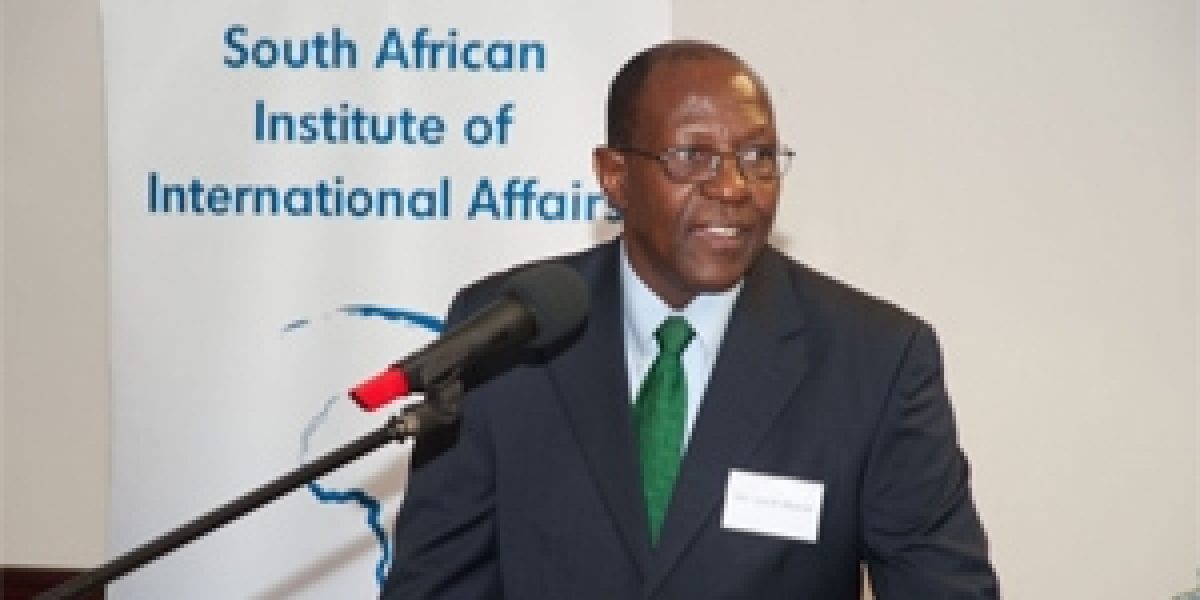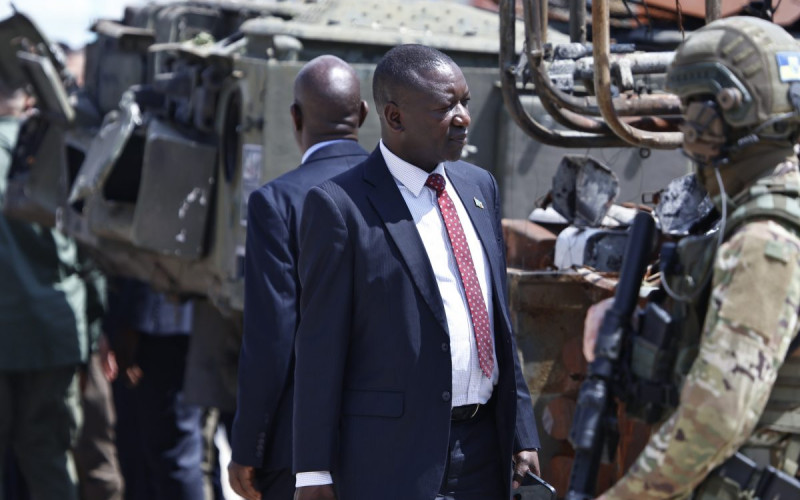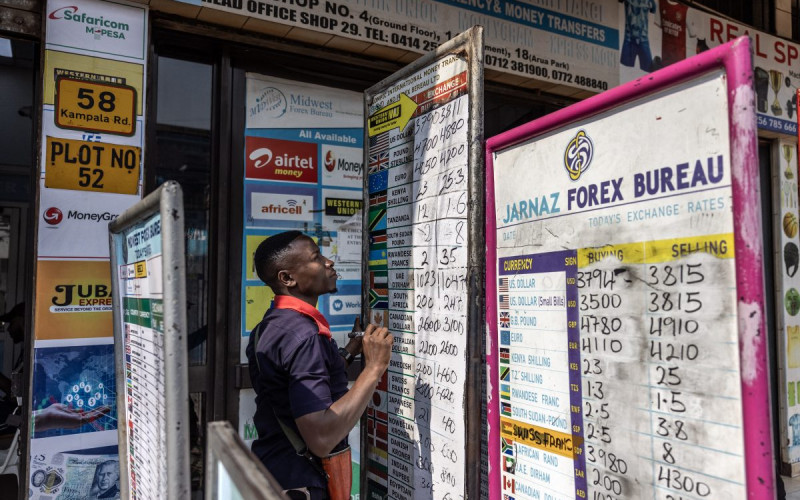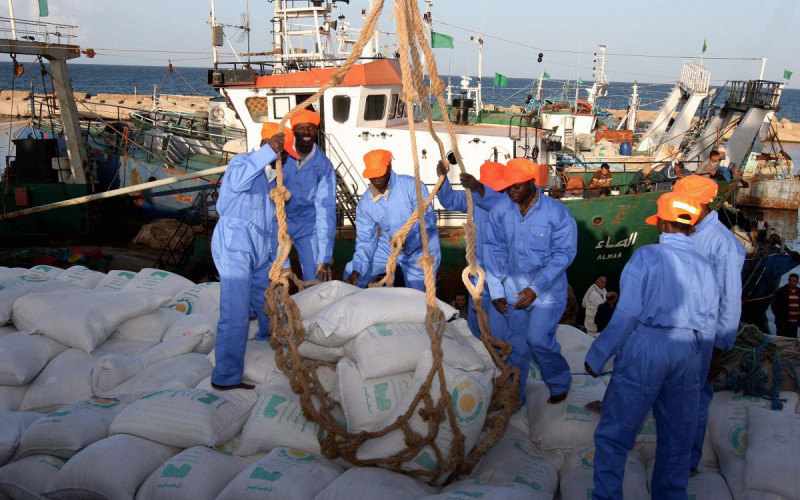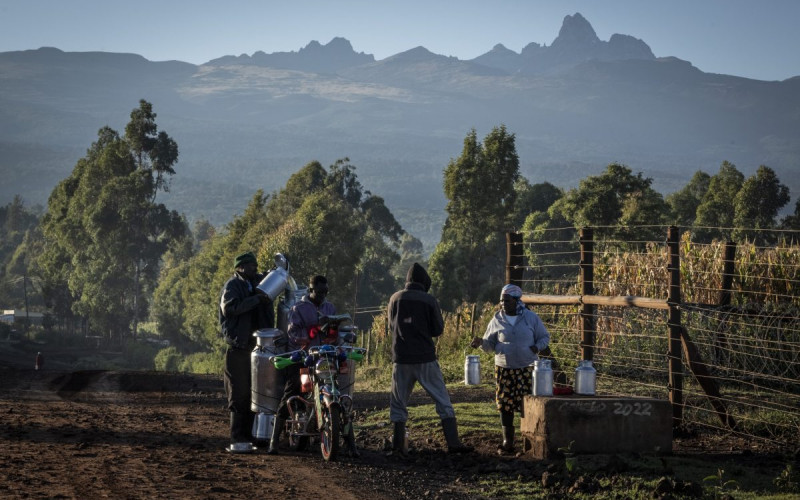This is the view of Ambassador Kaire Mbuende, the former Namibian Permanent Representative to the United Nations and former Executive Secretary of SADC.
In 2011, Dr Mbuende spent a number of months at SAIIA as the institute’s first Distinguished Visiting African Fellow. During his fellowship, he focused on some of the broader issues and debates of regional integration, especially in Southern Africa.
In this interview conducted by the former head of SAIIA’s South African Foreign Policy and Africa Drivers Programme (SAFPAD), Nomfundo Xenia Ngwenya, Dr. Mbuende examines some of the challenges facing SADC in terms of effective decision-making, the quality of its decision-making and the implementation of those decisions.
He proposes, amongst others, that a special committee of permanent representatives of Southern African states be established within SADC. A group of this kind, he argues, would have the authority to take decisions on behalf of member governments and would assist in streamlining and improving decision-making within the regional body. The aim is to ensure greater continuity between summit meetings and better quality decisions by providing sufficient time for reflection. He also suggests that SADC creates a its own Peace and Security Council that should include early warning mechanisms to better deal with the security challenges facing the region.
Question and Answer with Ambassador Kaire Mbuende on Regional Integration in Southern Africa
QUESTION: Mr Ambassador, you’ve suggested the establishment of a committee of permanent representatives of Southern African states to SADC. How do you think this would help speed up decision-making within SADC?
Ambassador Mbuende: There are two aspects to this. The first is that the committee would expedite decision making to the extent that it was authorised by member states to take certain decisions. At some point decisions have to be taken at a technical level, but if you’re working through a multilateral process they cannot be taken by the secretariat. But a committee set up on a permanent basis can take decisions on behalf of governments of member states. In that way a lot of decisions would not have to wait for extraordinary meetings of the council, or a summit, or a regular scheduled meeting. They would be taken on a continuous basis as issues arise.
The second aspect is one of quality decisions. At present decisions are taken too hurriedly because a Council of Ministers meeting only lasts for a week and in that week a great deal has to be done. First government officials, then ministers have to go through everything and make recommendations to Council, and Council must then adopt the decisions. Sometimes within two days of the Council’s meeting they have to make a decision and recommend action to the summit meeting.
The quality of decision-making tends to be poor simply because there’s insufficient time allocated for an inter-governmental process. A member government might have considered a single matter at great length in its capital but when it meets together with others as an inter-governmental body the meeting only lasts for a short period of time and therefore does not allow for an exhaustive discussion of issues in a multilateral process. Decisions are more often than not taken hurriedly without considering the implications of some of the decisions on member states. In short, we need enough time for reflection before arriving at final decisions. The proposed standing committee would have more time to deal with these issues and advise member states appropriately. It could consult with member states, research issues and in that way build a much sounder basis for its recommendations and/or decisions. I believe this would improve the quality of the decision-making process and ultimately of the decision itself.
This leads to a second point: the proposed establishment of a SADC Peace and Security Council. That would have a bearing on finding better ways of reaching consensus. How do you propose that it should function? What would the implications be, in particular for member states’ sovereignty?
The current situation pertaining to the SADC Organ on politics, defence and security is that its activities depend to a large extend on the Troika and particularly the country chairing it even though every member state has the right to draw the attention of the chairman to a situation that needs attention. Some countries have been proactive while others have been less so. In a way this is not unique to the SADC Organ, the same thing could be said about the UN Security Council.
The difference is, however, that there is a platform with regular meetings that enables member states to put matters of concern to them on the agenda of Council. At present the Organ seems to function more like a crisis response mechanism. If there is a situation that is getting out of hand it is usually brought to the attention of the Organ through the Chairman of the Troika, but there is no opportunity for reflection on the long term prospects and outlook.
When dealing with issues of peace and security early warning is important to allow for preventive diplomacy. At the moment most current threats to peace and security come from ‘non-traditional’ sources of conflict such as unemployment, economic crises and exclusion from enjoying a country’s economic opportunities and so forth. Given the complexity of the causes of conflict it is important that one takes a long-term view of these potential security threats and addresses them through other relevant instruments before they get out of hand.
A problem with the current structure is the old ‘Frontline States’ culture that is still lingering on, operating in an informal way. Even though there’s now a formalised structure with a protocol and regular meetings, there’s still an element of informality and also an attitude of dependence on the coordinating country, as we had in the old SADCC. At the moment the remnants of the past still dominate the culture of the organisation. In a way one sees old wine in new vessels.
We now have a unit within the secretariat that’s supposed to deal with issues pertaining to the Organ but it needs to be beefed up. It’s under-staffed and not really pro-active. Further institutionalisation of the mechanism for dealing with politics, defence and security is needed through the creation of a SADC Peace and Security Council.
The members of the Permanent Representatives Committee that I’m proposing could also cover the meetings of the Peace and Security Council. Depending on the issue under discussion, the Council can also meet at high level with inclusion of delegates from capitals at appropriate levels. The creation of the Council will definitely enhance the ability of the region to deal with issues of peace and security, including from a broader human security perspective.
There are certain issues that can and should be addressed through this proposed new council and in turn it could itself raise issues of concern to member states. We must bear in mind that we are bound together as a community. The slightest occurrence of instability or perception thereof in any one of our countries has far-reaching implications on the region as a whole. Instability in one country can have a social and economic impact on its neighbours. It can also tarnish the image of the region as a whole internationally. It is therefore necessary to have institutional capacity for decisive action to ensure that Southern Africa is indeed a haven of peace and stability devoting its resources to the welfare of its people.
A last political question: the SADC Tribunal. What’s your view on its recent dissolution and the implications for the integrity of SADC institutions?
Where do we start? I don’t know how to describe the history of the SADC Tribunal — maybe, as a comedy of errors.
I’ve already mentioned the quality of decision-making as an issue of concern. If we go back to the original SADC treaty, the Tribunal was intended to serve as dispute settlement mechanism on the interpretation of SADC instruments – what’s laid down in the protocol on trade and in other instruments. It was initially conceived as a body for dispute settlement and not a regional court. In fact a regional court was supposed to be provided for in the treaty as one of the principal organs of the community. Instead, the protocol on the Tribunal virtually turned this organ into a regional court. The protocol provided, inter alia, for the Tribunal to develop its own jurisprudence and so forth. This took it beyond its original remit.
The protocol was negotiated and agreed upon by member states. Furthermore member states fast-tracked the implementation of the protocol by bringing it into effect without ratification. There are a few countries in SADC where ratification is not required once the Head of State has signed a regional or international instrument. For the majority of SADC countries there is a need for ratification. Ratification of international instruments is a function of the separation of powers between the legislature and executive. The protocol was negotiated by the executive. It should have gone to the legislature for ratification but a decision was made that obviated the need for this and it thus came into effect.
The legal basis of such a decision can be questionable from the point of view of a number of countries. All the same, the decision was taken and implemented and the Tribunal became operational on that basis and cases were heard and judgements passed. What seems to have triggered the current impasse were not so much the procedural issues but rather specific pending cases pertaining to Zimbabwe. The Government of Zimbabwe was keen to find loopholes in the Tribunal and it found it in relation to the need for the ratification of the protocol.
From a strictly formal and administrative point of view there were merits in the arguments advanced by the Government of Zimbabwe but the timing cast doubt on the integrity of Community institutions. The SADC Summit called for a review of the role, responsibilities and terms of reference of the Tribunal while it was handling a number of cases. It was also not allowed to adjudicate even those cases that were straightforward.
The history of the Tribunal raises questions about the quality of decision making on the one hand and the integrity of institutions on the other. It is important that the review of the Tribunal is concluded quickly because as things are it casts a shadow of doubt over other institutions that are functioning properly. We should also move quickly because the entire issue of policy reversal has been a concern. Investors complain of coming into a country with a particular policy environment and finding that when another government comes into power it changes the policy and their investment is jeopardised. Stability is important in political institutions but also in terms of a continuing thread of policy.
Unfortunately the Tribunal is not a very good example of institutional integrity and stability. It raises issues that go beyond its own ambit, because you need to be confident that existing institutions will continue to function without interference. People would like to have certainty. If you’re asked whether a coup d’état is likely to cripple your country, for example, you may say that this will never happen. But without institutional stability that promise may not mean much. One wants to be able to give assurances knowing our institutions are strong and stable enough to defend individual or collective rights. I think the Tribunal is a sad story and it needs to be straightened out urgently.
What’s your assessment of the progress made so far in the Trilateral Free Trade Agreement (T-FTA)? In particular, what do you consider the main challenges and opportunities and how should they be handled?
The Trilateral FTA could be an instrument of political convenience to avoid a discussion on the overlapping membership in the three regional organisations. SADC, COMESA and EAC are three institutions with overlapping membership and each of them is committed to creating its own trade regime within its own area of operation. The geographic space covered by the three organisations largely coincides or overlaps.
Furthermore, the trade liberalisation programmes of the three organisations differ, or rather, the three organisations have different levels of ambition in terms of creating a common economic space. If one leaves aside the obligations and commitments of the countries of Eastern and Southern African under the World Trade Organization (WTO), then the question of which programme is being pursued in the regional context arises. Unfortunately, the T-FTA functions as a fourth force in addition to COMESA, EAC and SADC. It is not integrative in terms of bringing the three organisations into one institution nor is it integrating their trade regimes.
It does, however, serve a useful purpose as a platform for multilateral discussions between those countries that do not share a common membership in a regional organisation. Discussions on trade between countries that do not share a regional organisation are not merely bilateral, but have multilateral dimensions. What could have been a bilateral agreement becomes a multilateral agreement that might in the future be integrated into the programme of one or the other regional organisation — subsequently leading to the harmonisation of trade regimes between organisations. The impact of the T-FTA on the programs of the three existing organisations is not immediate.
The T-FTA in reality is an agreement among member states of SADC, COMESA and EAC and not between the organisations themselves. Member States are the ones that are going to drive the process rather than the three organisations. There is a need for a permanent mechanism beyond the joint committees to drive the process. There is a need for a secretariat that will help to facilitate trade and investments taking advantage of the scope provided for by the three organisations before the integration of their programmes in specific areas.
It is difficult to present T-FTA as an investment area for third parties if joint institutional mechanisms and a separate trade regime are not created that covers the area over and above what is offered by the three organisations. The T-FTA trade regime does not have to be more preferential than the three existing regimes but it must be well defined and differences with the other regimes clearly understood. If the T-FTA is not institutionalised, it will suffer the same fate as other broad initiatives such as the Cross-Border Initiative for Eastern and Southern Africa, the Indian Ocean Rim etc. that faded into oblivion.
The T-FTA could represent a great opportunity for development if significant strides are made to create common rules and procedures in trade and investment instead of mere production of documents of intent. The area has great potential in terms of intra-regional trade and investments as well as attracting foreign direct investment.
Earlier we touched on the integrity of institutions and decision-making. You wrote in a policy briefing:
“The greatest benefit that can be derived from a decisive implementation of the SADC Free Trade Area is the creation of confidence among business people. Trade liberalisation itself cannot bring about economic development. It is investments that create wealth through the production of … goods and services and [through] employment creation. The reduction of uncertainty about the risk of policy reversal is of crucial importance … buy-in by the private sector into the free trade area is of major significance.”
What role can SADC play in providing security on policy for investors?
There are lots of opportunities in the region, from Zambia to Malawi. Business people from South Africa and Zimbabwe who come into this environment have to be sufficiently confident that if they invest their money in one of the other countries the same rules that apply in South Africa or Botswana will also apply there. Case studies tell us that the premium on confidence is very high – in fact it’s the highest of premiums.
There are not many opportunities for trade in some of the SADC countries. In Southern Africa you don’t see an overwhelming range of products in the streets, because there’s no market for a surplus there: business people and farmers are able to sell everything they produce. In these countries you do not have a situation where people are producing with no market for their products. But to grow the market, to sell more, you have to produce more, which is why I stress investment. The challenge is to produce more which means investing and to invest successfully you have to address a range of issues such as labour legislation, and of course the broader policy environment.
Much of what we are saying about integration boils down to the fact that its greatest benefit lies in investment, the additional facility created when you move into new areas of opportunity. For example Namibia is exporting grapes to the EU but the exports are subject to quantitative restrictions by the EU. There are potential investors who are ready and willing to invest as soon as they know that Namibia can export more, but as long as the country is not allowed to export beyond the allocated quota they cannot invest because they do not know where they can market their products.
That’s how market access stimulates investment. For Africa its greatest benefit is not that we have products that we need to find a market for, but rather that we have resources that must be turned into products. The process of investment is capital-intensive and costly by its very nature, and there is risk associated with it. If risk is minimised, investment will flow and business people will take a chance on their investment. Financial risk is always there, but there should be no political risk and no risk of policy reversal. Business people are always prepared to take the commercial risk.
Do you think that there’s an appetite within SADC member states even to try to harmonise some of this legislation – some kind of mutual reinforcement of laws, sharing investment incentives and so on. Is any of that happening? Is there even a will to do so?
Most of the countries of the region have the same broad policy orientation. They provide similar incentives for investors ranging from repatriation of profits, training grants, mechanisms for arbitration in case of disputes between government and investors, allowing foreign investors to borrow on the local market etc. All the countries of the region are members of the Multilateral Investment Guarantee Agency (MIGA) of the World Bank. Most governments have also signed investments protection agreements with a significant number of developed countries. There has been a drive for harmonisation which was externally induced because of international obligations and/or conditionalities. At the same time there has been a process of policy harmonisation engendered by factors internal to the region and the region’s own policy options. Issues of trade performance, similarity in trade, competitiveness, market access and specialisation are key policy elements. The challenge is that there are no mechanisms to ensure compliance with common policies. Furthermore, competition for investments between the different countries has on occasions led to deviation from the norms. Investors place a high premium on consistency and predictability.
Next, a question on the EPA with the EU. In the same policy briefing you said:
“The challenge facing SADC today is to develop [the] institutional capacity to manage internal processes including dealing with popular constituencies or non-state actors and external dynamics that include relationships with broader frameworks such as the AU and Nepad, the tripartite agreement and the Economic Partnership Agreement (EPA) with the European Union (EU).”
How do you assess the manner in which SADC handled the EPA negotiation with the EU and what lessons does it present on how to improve SADC’s relations with extra-regional actors?
It’s a very useful lesson. There’s a need to cede sovereignty in multilateral trade negotiations, because we are trying to develop a trade regime between ourselves as a region on the one hand and with the EU or any other third party on the other. The outcome of any trade agreement with a third party should promote and enhance regional integration and not undermine it. It’s important that we negotiate as a team to ensure that our common objectives are preserved and reflected throughout the negotiating process. It seems to me that we also have to create a professional trade negotiating body made up of experts to be drawn from different walks of life with relevant skills and expertise. They could be professors in economics and trade and/or private sector people who know the markets and details about specific products, and of course it would include government officials who are ultimately responsible for policy.
The co-opted experts would be nationals just like the government officials. What is the difference? The professor from any university is as patriotic as the officials of the department of trade or any other relevant government department. Such ‘outside’ experts, added to equally patriotic business people with a vested interest in obtaining better trading terms and committed to negotiating a successful trade agreement that will benefit their country, should be key stakeholders in that process. Behind them, obviously their government is responsible for ensuring that the outcome is consistent with policy.
Other regions, for example the Caribbean, have established permanent negotiating organs. For us, the lack of such a body is a weakness, not only at the level of the SADC but also at a national level. As it is, the director general or permanent secretary of a department can be left sitting in Geneva for a month negotiating trade. He’s supposed to be running a department but instead he’s negotiating. I believe we are the only region that doesn’t have a permanent group of trade negotiators or negotiating bodies. Taking the American example, one finds that it’s not the person running the department who goes out and negotiates. He gives policy directives, but he has got experts who know the issues intimately, who pursue the interest of their country or region and do the negotiating. We need to create a professional body of that kind.
There’s the further issue of each country negotiating separately in international forums while they pursue a common trade regime at the regional level. The predecessor of EPAs, the Lomé Convention and the Cotonou Agreement, respectively, were of such a nature that countries negotiated commodities-based agreements. Those agreements were not comprehensive but rather they consisted of specific protocols. The beef protocol, for example, was negotiated between the EU and beef-producing countries such as Namibia and Botswana, so member countries like Zambia and Malawi that don’t export beef were not interested parties. There were also other protocols such as the sugar and banana protocols that were only of interest to those countries producing those commodities and the EU. We have now moved from that fragmented approach to a comprehensive partnership agreement, which ought to give rise to greater partnership among countries from the ACP, including the SADC region. It is obvious that each country was protecting its own interests, but the way it was handled was not good for the region. We did not have a permanent institutional capacity for negotiating and for following-up issues in our trade and economic relations with third parties. That is something we must develop. To me the biggest problem is that it’s an ad hoc process, this official going to this meeting and then to the next, and a different official going somewhere else.
Naturally there are those who decided not to engage in the EPA through SADC negotiation. Part of that problem is of our own making and part of it the EU’s, because a substantial number of SADC states are classified as least developed countries and therefore qualify for market access under the ‘everything but arms’ (EBA) arrangement with the EU. So all these negotiations become academic for them, because leaving aside countries with access through EBA or least developed country status, the only remaining interested countries were Namibia, Botswana and to a certain extent Zimbabwe and Swaziland. Lesotho is a least developed state, as are Tanzania and Angola. And in addition we had to take into account the EU’s EPA with South Africa. All these factors somehow complicated the negotiating process, but if we’d had a permanent institution as I have suggested it would have negotiated a broad framework, and then allowed for specifics to be dealt with on a case-by-case basis. Some of the issues, such as beef, sugar, bananas and so on, are specific but the broad framework could have been negotiated by everyone together.
You make an interesting point in believing that negotiations cannot be left to government, you need technical experts on products or a range of products, which government will always have limited capacity to handle. But maybe that approach only comes with political maturity. I’m not sure how many of our governments might be willing to involve non-governmental experts in negotiating.
It is not something new for governments to rely on the capacity of their citizens to achieve social and economic objectives. Governments already appoint people to boards of state institutions. So if you establish a body to handle negotiations, you can do much the same thing: appoint citizens from different backgrounds ranging from academia to business leaders who are successful in particular areas. It is in the enlightened self-interest of non-state employees to negotiate for the best possible outcome in international trade. Governments have also included people from the private sector as advisors and observers on some of the international trade negotiations. This is a national issue and the governments should mobilise the best possible brains in the country for a positive outcome. If a board of negotiators is created then nationals from a broad range of backgrounds and skill sets could be appointed. There is a need to diversify and thereby augment the professionalism of our negotiating teams. Governments should speedily tap into the capacity from sources outside government to help us obtain and implement successful international agreements that work for Africa.
Development cannot depend only on those few people who work for governments. It involves everybody, the private sector, academia, NGOs and other non-state actors. The greatest challenge we face is the capacity of African states and African institutions to negotiate internationally and get outcomes that protect and promote the interests of the African people. That’s key, and to do it we need to bring everyone’s skills and knowledge into the process.
Ambassador Kaire Mbuende took up the first Distinguished Visiting African Fellowship at SAIIA during 2011. This award is funded by the Oppenheimer Memorial Trust.
He is the former Ambassador and Permanent Representative of the Republic of Namibia to the United Nations as well as a former Vice-Chairman representing Africa on the Bureau of the 17th session of the Commission on Sustainable Development. He served as the Executive Secretary of the Southern African Development Community (SADC) from 1994 to 1999.
The interview was conducted by the former head of SAIIA’s South African Foreign Policy and African Drivers Programme (SAFPAD), Dr Nomfundo Xenia Ngwenya.

